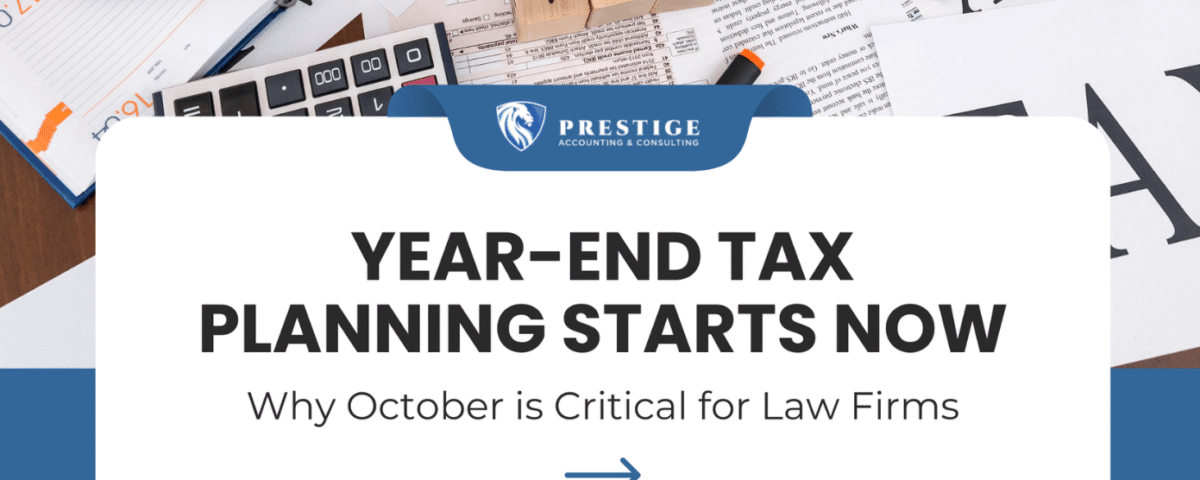
Profit Pillars 2025
September 30, 2025
Maximizing Tax Deductions Before December 31: A Guide for Attorneys
October 7, 2025
Categories
Year-End Tax Planning Starts Now: Why October is Critical for Law Firms
wait If you’re waiting until January to think about taxes, you’re not planning. You’re reacting.
And as a law firm owner, that reaction can cost you tens of thousands of dollars in missed deductions, avoidable penalties, or poorly timed distributions. October isn’t the end of the year. It’s the last call for proactive decisions that can change your entire tax outcome.
At Prestige Accounting & Consulting, we specialize in helping lawyers and law firm owners create tax strategies that actually work—not just during tax season, but all year long. This guide explains exactly why October is the most important month for tax planning—and what our clients are doing right now to stay compliant, lower their tax liability, and prepare for 2026 with confidence.
Why October Matters for Law Firms
Let’s be real: December is a blur. And by January? Your options to make meaningful tax changes are nearly gone.
October gives you a unique advantage:
- You have 9+ months of financials to work with — a nearly complete year to forecast.
- You still have time to move — to invest, defer, distribute, contribute, or correct.
- You can catch issues before they become audit triggers — like trust reconciliation gaps, owner draws, or payroll missteps.
If you wait until the tax prep appointment to discover your errors, you’re writing a check. But if you act now? You’re writing strategy.
💸 1. Run a Mid-Year Financial Review—Like a Real CFO Would
October is the perfect time to run a mini internal audit.
Here’s what we look at during our mid-year financial review sessions with law firm clients:
- YTD Profit & Loss – Are you more profitable than expected? Great—now let’s plan to reduce tax liability before Q4 ends.
- Trust account balances – Is everything reconciled? Are any earned fees sitting in the wrong place?
- Payroll & Compensation – For S Corp owners, we examine whether your W-2 salary is still “reasonable,” if your distributions are being handled properly, and if you’ve withheld enough taxes.
- Estimated Taxes – Are your quarterly payments in line with actual profits? Many firms overpay or underpay due to poor forecasting.
Most attorneys don’t track this until it’s too late. That’s how surprise tax bills happen.
🧾 2. Use Strategic Spending to Lower Taxable Income
Strategic is the key word here—not spending just to spend.
Here are moves we recommend only when they align with your long-term goals:
➤ Prepay Expenses
If you’re on the cash basis of accounting (and most small firms are), paying for 2026 expenses in 2025 lets you deduct them now.
Examples:
- Bar dues or CLEs
- Software subscriptions
- Marketing campaigns
- Equipment purchases
- Professional memberships
Pro Tip: Don’t do this blindly. Over-spending can tank your Q1 cash flow. But done right, it’s a legitimate strategy to control your bottom line.
➤ Use Section 179 and Bonus Depreciation
Section 179 allows you to fully deduct the cost of equipment placed in service before December 31. This includes laptops, office furniture, and practice-specific tools like case management systems.
- 2025 Section 179 limit: $1,220,000 (phaseout starts at $3,050,000)
- Bonus depreciation is still available at 60% in 2025 (down from 80% in 2023)
If you’ve been considering an upgrade—this is your reminder. Buy it, use it, and deduct it.
🏛️ 3. Retirement Contributions: Big Deductions That Build Wealth
Let’s talk tax deferral.
Solo attorneys and firm partners have access to powerful tax-saving accounts like:
- Solo 401(k) – up to $70,000 contribution for 2025 if you’re under 50
- SEP IRA – up to 25% of your net self-employment earnings (capped at $69,000)
- Defined Benefit Plans – for high-income firms, you can contribute over $150K/year with the right setup
And yes, you can still set up these accounts now if they don’t already exist.
📌 Reminder: Many retirement accounts must be opened and funded by year-end to count. October is your deadline to explore and implement.
⚠️ 4. Avoid These Common Q4 Mistakes We See in Law Firms
You’re not the only one behind—but ignoring these is where real damage happens:
|
Mistake
|
Why It Hurts
|
|
No tax savings plan
|
Leads to unnecessary overpayment (or underpayment penalties)
|
|
IOLTA not reconciled
|
A red flag for bar audits and compliance violations
|
|
Misclassified contractor payments
|
Could trigger IRS and state penalties
|
|
Waiting to fund retirement
|
Misses the window to reduce taxable income
|
|
S Corp owners overdrawing without payroll
|
Big audit trigger—and potential back taxes owed
|
October is when these are fixable. December is when they become regrets.
📑 5. Plan Your Q4 Estimated Tax Payment (Due Jan 15, 2026)
This payment covers income earned in October through December. But most law firm owners guess—or use outdated benchmarks.
Here’s what we recommend:
- Run a profit projection for the full year using actuals from January–September and a Q4 estimate.
- Calculate your total expected tax liability, factoring in both federal and state income taxes.
- Subtract what you’ve already paid in Q1–Q3 estimated payments.
This gives you a realistic number to send in January—and avoids both overpayment and underpayment penalties.
Need help calculating? Let’s walk through it together →
📚 Final Tip: Tax Planning Is a Year-Round Sport. But Q4 Is Game Time.
Being a law firm owner is already a full-time job. Don’t let tax planning become a stressor you push off until “after the holidays.”
You’ve still got time—but not for long.
Let us help you build a plan that:
- Reduces your 2025 tax bill
- Protects your cash flow
- Keeps you compliant with IRS and state bar rules
- Puts you in a stronger position for 2026




